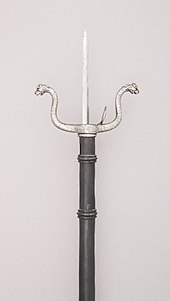Stick with retractable blade
The stick or staff with retractable blade is a stabbing weapon with the outward appearance of a hiking or walking stick or pilgrim's staff .
technology
In terms of the intention of taking up a hidden blade, the stick with a retractable blade is similar to the stick rapier , but has a completely different construction principle. In a sword-stick which is blade on the handle attached, the remaining hollow floor serves as a sheath . After pulling it out, it is used like a sword .
In the case of a stick with a retractable blade, the blade (or several blades in some types) is concealed in the direction of the handle. As with a drop knife , the blade, driven by a jerky movement, pops out of the stick and is locked by means of a mechanism driven by spring force . With the blade extended, the stick is used like a short skewer . Some of these weapons also have protruding side blades as parrying elements to ward off the opponent's blade. In order to lower the blades again, the locking mechanism must be released by hand.
history
Sticks with retractable blades appeared in the late 16th century . They come mainly from northern Italy , including Turin and Milan . But there are also known specimens from Germany .
In this regard, different names and theories published in the literature cause confusion. The Italian “brandistocco” or French “brin d'estoc” was often adopted as a designation. Since this designation can often be found in the historical inventory lists of the armories , it was assumed that these sticks were used on a large scale. Accordingly, officers should have carried these sticks outside of duty. The term “brandistocco” is a runke , a military polearm with smaller secondary blades. Recent findings rule out the assumed frequent use by officers. In addition, in Anglo-Saxon literature at the beginning of the 20th century, sticks with retractable blades were incorrectly referred to as "swine's feather", "leading staff" or "feather staff". According to recent studies, these names stand for polearms with the possibility of supporting muskets .
Sticks of this kind were used primarily for self-defense on wanderings or pilgrimages . Some of these sticks are decorated with a pilgrim shell , which supports this assumption.
In Italian, weapons with retractable blades are generally called "buttafuori", ie sticks with one or more blades, but also battle hammers and battle axes . The staff with three retractable blades is specified in Italian with the addition “ad alette” (German: “with wings”). The total length of this type comes extended to up to two meters. Compared to the polearms that were common at the time, production was much more complex.
In the 19th century sticks were with retractable blades in series production. These were based on the walking sticks customary at the time. As a result, the overall length was significantly shorter.
literature
- George Cameron Stone : A Glossary of the Construction, Decoration and Use of Arms and Armor: in All Countries and in All Times , Southworth Press, 1934 [1]
- Lennart Viebahn: Buttafuori ad Alette
- Carlo De Vita: Dizionari terminologici: Armi bianche dal Medioevo all'Età moderna , 1983, ISBN 978-8870380842 [2]
- Heinz Werner Lewerken: Combination weapons of the 15th – 19th centuries Century. Military publishing house of the German Democratic Republic , 1989, ISBN 3327005168
- Harold Dillon : The feather staff in: The Archaeological Journal , 1907 [3]
Individual evidence
- ↑ Lewerken: combined arms , 1989, p 133
- ↑ Lewerken: combined arms , 1989, p 134
- ↑ Lewerken: Kombinationswaffen , 1989, pp. 277-278, 283
- ↑ Lewerken: combined arms , 1989, p 134
- ↑ a b c d e f g h i Viebahn: Buttafuori ad Alette
- ↑ Lewerken: combined arms , 1989, p 134
- ↑ a b Stone: Glossary ... of Arms and Armor , 1934, p. 227
- ^ Vita: Dizionari terminologici: Armi bianche , 1983, plate 58
- ↑ Lewerken: combined arms , 1989, p 134
- ^ Vita: Dizionari terminologici: Armi bianche , 1983, plate 70
- ↑ Lewerken: combined arms , 1989, pp 277-278
- ↑ Lewerken: combined arms , 1989, p 133
- ↑ Lewerken: combined arms , 1989, p 137
- ↑ Lewerken: combined arms , 1989, p 171

